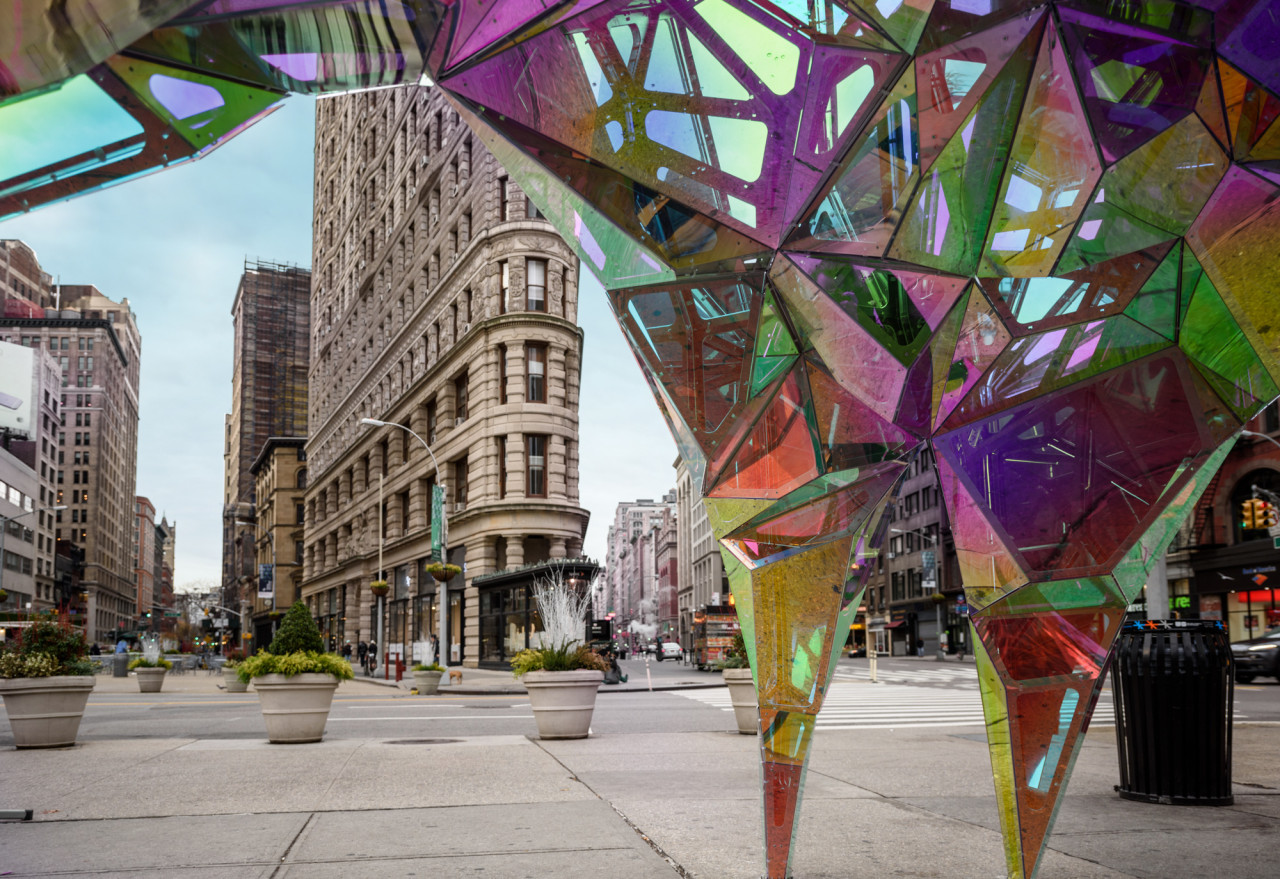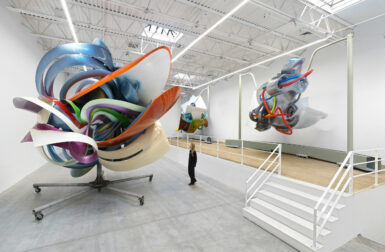Michael Szivos, who founded SOFTlab in 2005, has said that the New York-based design studio is about material, experience, effect and engagement. Four words that go a long way toward explaining why the studio’s collaboration with 3M is so successful—it’s certainly hard to imagine a more material- and experience-centered company.
“Many engineers, architects, designers and artists around the world are using our 3M materials as a great source of inspiration,” said Eric Quint, Chief Design Officer of 3M Company. “Their specific structures, visual appearances and physical properties give endless opportunities to experiment with and create new solutions. Our collaboration with designers like Michael Szivos at SOFTlab, help us explore the boundaries beyond imagination and amplify the way people interact with our materials into new experiences.”
Last year the design studio won Flatiron Public Plaza Holiday Design Competition and then collaborated with 3M on Nova, an installation that created an urbanized gazebo.
The exterior of the cell-like structure was clad in aluminum while the interior was laminated with 3M Dichroic Film, which created a glowing, kaleidoscopic effect. When SOFTlab partnered with 3M for the LifeLab at SXSW 2015, they again reached for 3M’s dichroic film. It is a magical product. The film mimics the look of dichroic glass—a material that the Romans were fond of using. The Romans managed to get the iridescent effect by sprinkling minuscule particles of gold and silver into the glass and then crafted drinking glasses, vases and jewelry. The 3M film version is a lot less time consuming than trying to melt nano-sized particles into glass—but is certainly equally as awe-inspiring. We asked the SOFTlab team about their inspiration, organizational strategies and the process for creating installations that wow.
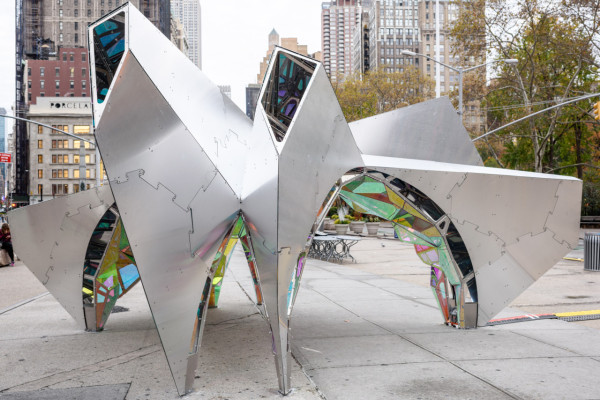
The interior of aluminum structure of Nova is clad in acrylic and laminated with 3M Dichroic Film creating a kaleidoscopic effect.
Where do you tend to find your inspiration?
We get inspiration from many different things, which is key to how we approach the beginning of projects. We do not exclude anything as a potential inspiration, whether it’s banal, or something exceptional. The translation of what inspires us into aspects of a project is where I think some of the real conceptual invention happens.
Who are some of your favorite designers?
We look at a number of designers in many different professions, but the ones that have come up lately include Nendo, Jasper Morrison, Universal Everything, Random International, Sou Fujimoto, and Aaron Koblin.
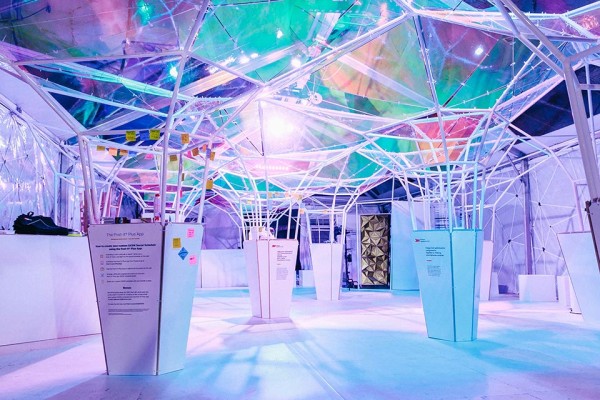
The 3M LifeLab at SXSW created (with BBDO) was designed to turn the interior of the 3M pavilion into a kaleidoscopic prism using 3M’s dichroic film.
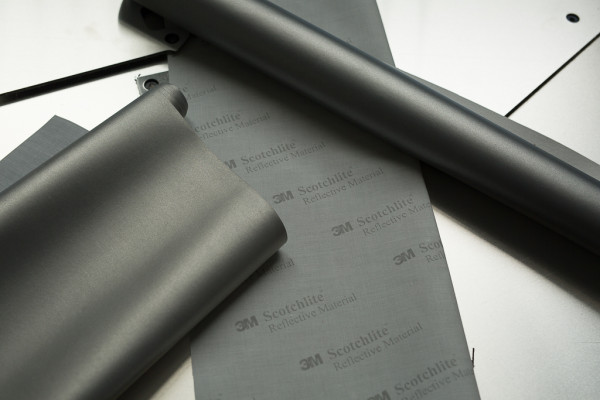
3M™ Scotchlite™ Reflective Material
What kinds of materials and mediums are you drawn to?
In general we use materials that can act both as surface and structure. Rather than a material simply being used to create a surface or form, we try to use materials that do more in terms of creating a spatial condition through transparency, reflection, and coloration. We are drawn less to specific types of materials, and more so to the combination of materials that might seem out of the ordinary.
The unexpected nature of how we use materials allows us to produce a more engaging experience that relies on discovery and the creation of what we hope is a more personal experience. For example, 3M makes some really amazing materials, and it is always exciting to look through their catalogs and find a material that might be for an industrial application that most people would never see, and repurpose it in a way that creates a sense of wonder and frames it as something that has been beautifully engineered.
What are the tools that you reach for on a daily basis?
For me personally, I tend to reach for a pen and any paper that is around to quickly sketch out ideas, simply because my schedule is too busy to sit down and look at things more precisely. The studio on the other hand, uses a wide range of tools. Our studio has historically produced work that is both designed and produced using sophisticated digital tools. That will of course continue, but we are making a larger effort to be agnostic towards tools in a way that allows us to consider new ways of working. This helps us rediscover the ways that we are currently working, very much similar to the way that we approach materials.
You’ve created projects across a range of interesting forms, including digitally fabricated large-scale sculpture, interactive design, immersive digital video installations and more. Do you have a favorite type or style for your pieces?
We try not to have a particular style, although our interests tend to produce what might be considered similar forms. I think this is mostly driven by different lines of research within the studio that have become more refined. I find projects exciting when these different branches of research can be combined into one for a project. At the moment I am really interested in opportunities where we can experiment with the combination of tangible interaction, and more spatial built work.

The structure was made up of over 1200 unique 3D printed joints.
Many of your installations have incorporated materials traditionally used in very different ways, such as 3M Dichroic Film, typically used for architectural application to glass and plastics. How do you draw inspiration from unique materials to find new creative and imaginative ways to use them?
We typically seek out our materials based on a spatial idea we have, and maybe a particular effect we would like to achieve. Sometimes a material itself inspires this idea, which is often the case with 3M materials. What’s exciting to us is the idea of using materials that have been engineered for a specific performance, in a different and unexpected way. For example, many of 3M’s materials have unique optical aspects that allow us to design with light as a spatial element. The 3M Dichroic Film in particular looks different depending on a person’s orientation to it, which makes it a very exciting material to us.
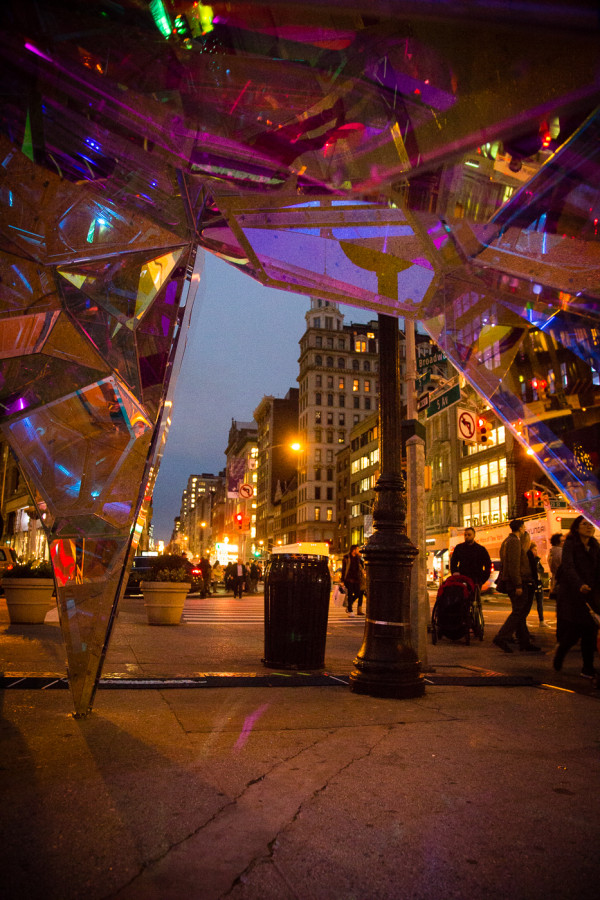
The Nova, the result of the Flatiron Public Plaza Holiday Design Competition.
How do you keep yourself organized?
Personally I try not to keep a physical list or calendar of “things to do.” I think I keep a pretty good mental calendar, but I do this more because I believe in the ability for chance to invade my schedule, which sometimes becomes difficult when everything is too organized. This is made easier for me because I think the studio is fairly organized as a whole.
Over the years we have become really good about organizing and scheduling complex projects with many unknown factors. With that said, we always allow for contingencies, and plan on having to improvise to a certain degree. In terms of installations, it is exciting to bring something unexpected into the real world. However the real world has some exciting tricks of its own – such as wind, humidity, misread dimensions, and small children running around!
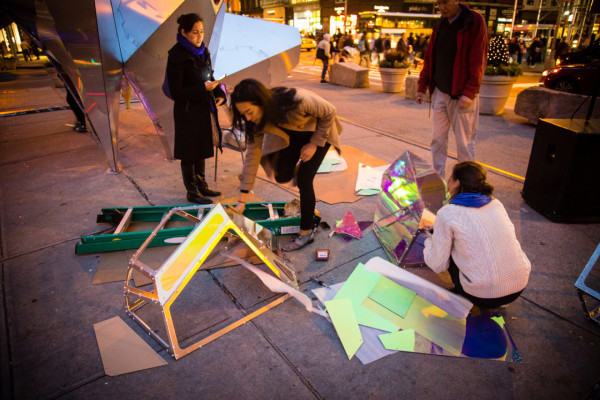
Creating the Nova, as part of the Flatiron Public Plaza Holiday Design Competition
You have created captivating structures in very public spaces, such as the “Lifelab” structure at SXSW, and the “Nova” installation in the Flatiron District of NYC. What messages or emotions do you hope to convey to the public with your work? How do you try to communicate this through your designs? What role do the selected materials play?
We often try to create a sense of wonder, surprise, and engagement with our installations and the materials that we use play a big part in that. We try to create projects that are strange, but seem to blend in based on their unique site specificity. In this way they are oddly contextual, and they fit in through how people experience them, rather than by looking like their surroundings.
We really want our work to be easily accessible and I think the unique qualities of 3M materials do that. Most people have experienced 3M materials at some point in their everyday life, which gives an installation a point to which they can relate. After looking at the installation closer though, people realize that they have never seen them used in this way before. We strive to have our installations become a unique experience for everyone and in that sense they also become the authors of the project – remembering and sharing their own stories about how they engaged with it.
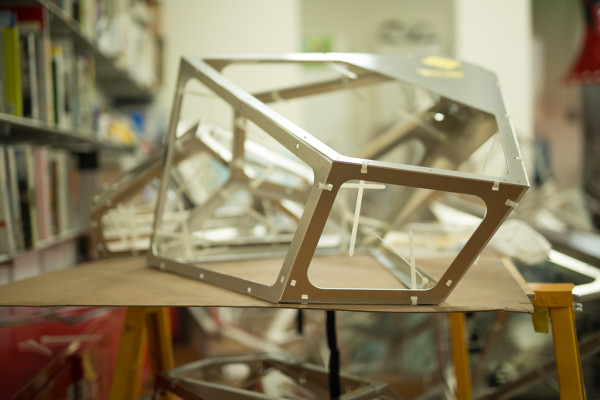
Behind the scenes of the making of Nova ( Flatiron Public Plaza Holiday Design Competition).
Can you tell us a little bit more about what went into making the past installations you have done with 3M materials? What was the “behind-the-scenes” like?
The behind-the-scenes activities are probably very different from what everyone imagines. The installations themselves are fairly complex and made of many pieces. Although they look organized, they are anything but. You will often see heaps of various parts organized into numerous piles and stacks, and many drawings and diagrams being made to help convey how everything goes together.
I find that the logistics and behind-the-scenes activities to be completely separate projects for us. It’s exciting how different it is from designing the project, in that it is much more of a logistical and pragmatic problem. This is what I have come to understand in our work as a mix between what might be considered an exuberant or strange design and the extreme pragmatism and/or engineering that then takes place to make it happen.
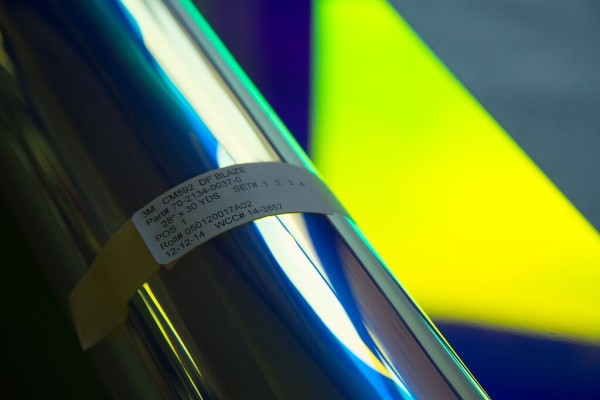
3M™ Dichroic Film
What about these materials make them so unique and interesting to you as a designer?
These materials are multi-dimensional and are visually appealing, which is why most designers use a material. Many 3M materials have qualities such as optical, tactile and performance qualities that make them more than a simple flat surfacing material.
What books are on your nightstand these days?
Lately, I have been interested in how we might introduce some of the idiosyncratic qualities of analog production into the processes we use, which are very precise and digitally driven. Most of what I am currently reading has to do with these types of ideas, and how we might subvert the style normally associated with digitally based work. I am currently reading a catalog of Martin Puryear’s artwork, The Alphabet and the Algorithm, and Nothing Less Than Literal: Architecture After Minimalism.
What advice would you give to a young artist or designer just starting out?
I would say understanding what your strengths and weaknesses are is very important. I think this allows you to question the status quo in both the world, and in your own work, and more importantly to take on risk in a calculated way. To me, design is not only about pushing the boundaries of what people expect to see in the world, but also about what you can create. I believe it may be easier for young designers to take on risk, but I also think that this is important for designers at any level to do so they can explore what is possible.
See more of SOFTlab’s work here and learn more about 3M’s Dichroic Film here.


